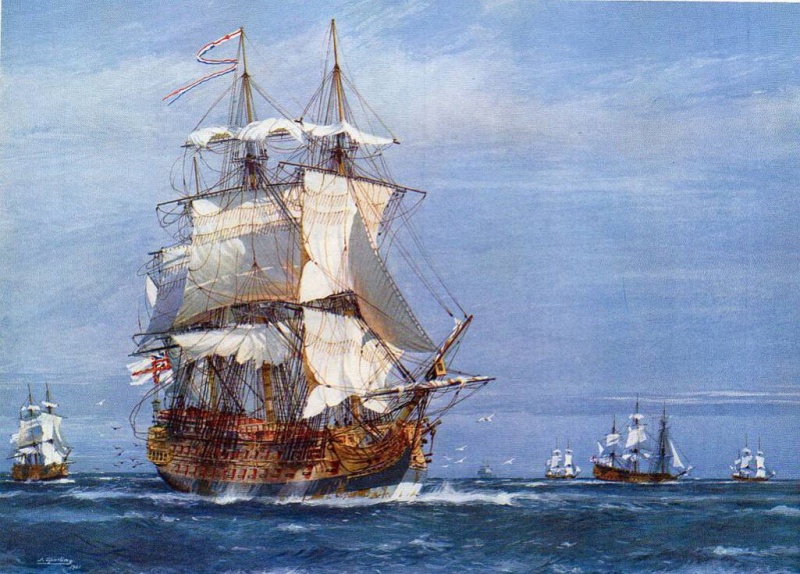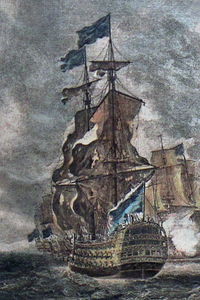HMS Namur (1756)

HMS Namur.
Originally ordered to the Neptune class specifications in July 1750, HMS Namur was altered to a modified design by William Bately during construction, by lengthening the gundeck by four feet, but shortening the keel. What emerged was a 90-gun second rateship of the line, built at Chatham Dockyard to the draught specified by the 1745 Establishment amended in 1750, and launched on 3 March 1756.
HMS Namur’s battle honours surpass even those of the more famous HMS Victory.
GREAT BRITAIN Name: HMS Namur Ordered: 12 July 1750 Builder: Chatham Dockyard Launched: 3 March 1756 Fate: Broken up, 1833 Notes: ·Participated in:
·Siege of Louisbourg (1758)
·Battle of Havana (1762)
·Battle of Cape St Vincent (1797)
·Battle of Lagos
·Affair of Fielding and BylandtClass and type: 1750 amendments 90-gun second rateship of the line Tons burthen: 1814 bm Length: 175 ft (53.3 m) (gundeck) Beam: 48 ft 6 in (14.8 m) Depth of hold: 20 ft 6 in (6.2 m) Propulsion: Sails Sail plan: Full rigged ship Armament: ·90 guns:
·Gundeck: 26 × 32 pdrs
·Middle gundeck: 26 × 18 pdrs
·Upper gundeck: 26 × 12 pdrs
·Quarterdeck: 10 × 6 pdrs
·Forecastle: 2 × 6 pdrs
History.
HMS Namur figurehead, Naval Museum of Halifax, CFB Halifax, Nova Scotia, Canada
By Hantsheroes - Own work, CC BY-SA 4.0, https://commons.wikimedia.org/w/index.php?curid=53811666
Namur was the flagship of Edward Boscawen Vice Admiral of the Blue in the capture of Louisburg in 1758. General James Wolfe had sailed across the Atlantic in Namur on this occasion before his capture of Quebec. Also on this journey was 6th Lieutenant Michael Henry Pascal with his slave and servant Olaudah Equiano who at that time was called Gustavus Vasser, his slave name given him by Pascal. Equiano in his book wrote that the ceremony of surrender was "the most beautiful procession on the water I ever saw", and gives fuller details.
In 1758, fifteen Namur sailors were tried and condemned to death by hanging for mutiny; they had protested to be replaced aboard another ship. King´s grace reprieved them from death penalty except one. (Leonard F- Gutteridge: Mutiny - a list of naval insurrection", 1992 Annapolis USA)

HMS Namur at the Battle of LagosBy Richard Perret (active in 1806) - Own work, Public Domain, https://commons.wikimedia.org/w/index.php?curid=14856944
Namur was the Flagship of a British fleet commanded by Sir Edward Boscawen at the Battle of Lagos which took place between the British and and a French fleet under Jean-François de La Clue-Sabran over two days in 1759.
Namur was also the flagship of Admiral Sir George Pocock at the Battle of Havana (1762).
Paid off for repairs from November 1765 until March 1766 she was not recommissioned until October 1770 under Captain Walter Griffiths for service in the Falkland Island dispute. Paid off again in July 1771 for great repairs at Chatham. In 1780 she was coppered at Portsmouth prior to being recommissioned in 1795 under Captain James Hawkins-Witshed for Channel service.
Namur fought in the Battle of Cape St Vincent (1797) under the command of Captain Whitshed. Namur was the ship astern of HMS Captain, under the command of CommodoreHoratio Nelson, at the beginning stages of the battle.
Namur was razeed to a 74-gun ship between June 1804 and May 1805. Her new Captain was Lawrence Halstead. Under him she took part in Strachan's naval engagement of 4th Nov. 1805 (Battle of Cape Ortegal), when the remnant of the French and Spanish warship fleet which had escaped from Trafalgar was engaged by Lord Strachan's squadron; she took on and captured the French warship "Formidable".
Serving in Warren's squadron throughout 1806, she paid off in July 1807. She was de-marked as a receiving ship at Chatham, and then to lie at the Nore as a guard ship under Captain Richard Jones.She remained in that role until finally paid off in September 1815.
She was finally broken up at Chatham in 1833.
Some of Namur's timbers were used to support the floor of the wheelwright's workshop at Chatham Dockyard. They were rediscovered there in 1995 and identified in 2003. The restored timbers form the centrepiece of the "Command of the Oceans" gallery at the Chatham Historic Dockyard museum opened in 2016.
Notable crewmembers.
- The marine painter Clarkson Stanfield served on board the ship, after being pressed into the Royal Navy in 1808. He was discharged on health grounds in 1814.
- One of Namur's captains was Charles Austen, a brother of Jane Austen.
- Olaudah Equiano, a former African slave who was active in the British abolitionist movement, served as a powder monkey on Namur.








Bookmarks